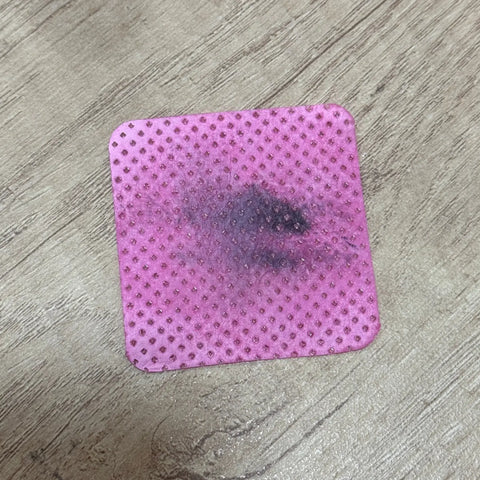Have you ever applied gel, cured it and noticed that there is a sticky layer on top? This sticky layer is also called the inhibition or dispersion layer and is totally normal. It does not mean that you gel has not cured properly and is a typical feature of all gels (although not all inhibition layers feel sticky). If you tried to remove the sticky layer of a gel polish some colour may come off on the wipe used to remove it, like below, do not worry this is normal!

What is an inhibition layer?
In basic terms it is uncured gel. The inhibition layer, also known as the tacky or sticky layer, is a thin, sticky residue left on the surface of gel nail products after curing, this layer is a byproduct of the curing process.
Why is there an inhibition layer?
The inhibition layer forms due to oxygen exposure during the curing process. UV or LED light initiates a chemical reaction called polymerisation, that causes the gel molecules to harden, but the presence of oxygen prevents the surface layer from fully curing. The reason this happens is that oxygen blocks/ inhibits the ends of the polymer chains which means that they cant get any longer.
This layer is an inherent characteristic of gel products and allows for better adhesion between layers of gel, which is why it's beneficial when applying multiple coats or adding nail art.
Should i remove the inhibition layer?
In short YES and NO. Its important to remember that "sticky gel sticks to gel", removing the sticky layer of gel between coats of gel can impair the new layer of gel ability to stick to the previous layer of gel below.
Unless otherwise directed by your brand, you should not remove the inhibition layer between coats of gel (i.e between colour coats or before top coat) UNLESS you are refining the layer of gel. If you are refining a structure gel, such as builder gel or hard gel, you should remove the inhibition layer before refining. The refining process itself will create a grippy enough surface for the next layer of gel to adhere to. In short if you have to remove an inhibition layer for any reason, you should buff the gel before applying another layer.
What about "Non-Stick Top Coats"?
As we have discussed, an inhibition layer is an inherent characteristic of gel products, this means that there is almost always an inhibition layer of gel on top, even though you sometimes cant feel the sticky sensation. As a result there is an argument that even top coats that are non stick, should too be wiped after application.
How do i wipe away an inhibition layer?
When wiping away an inhibition layer you want to use IPA (Isopropyl Alcohol) or an IPA based product, such as our multi purpose sprays , which smell divine! Simply apply your chose product to a lint free wipe and thoroughly rub over the gel.
When removing the inhibition layer from a top coat my recommendation would be to wait around 30 seconds to a minute for the nails to cool to avoid dulling the shine.

